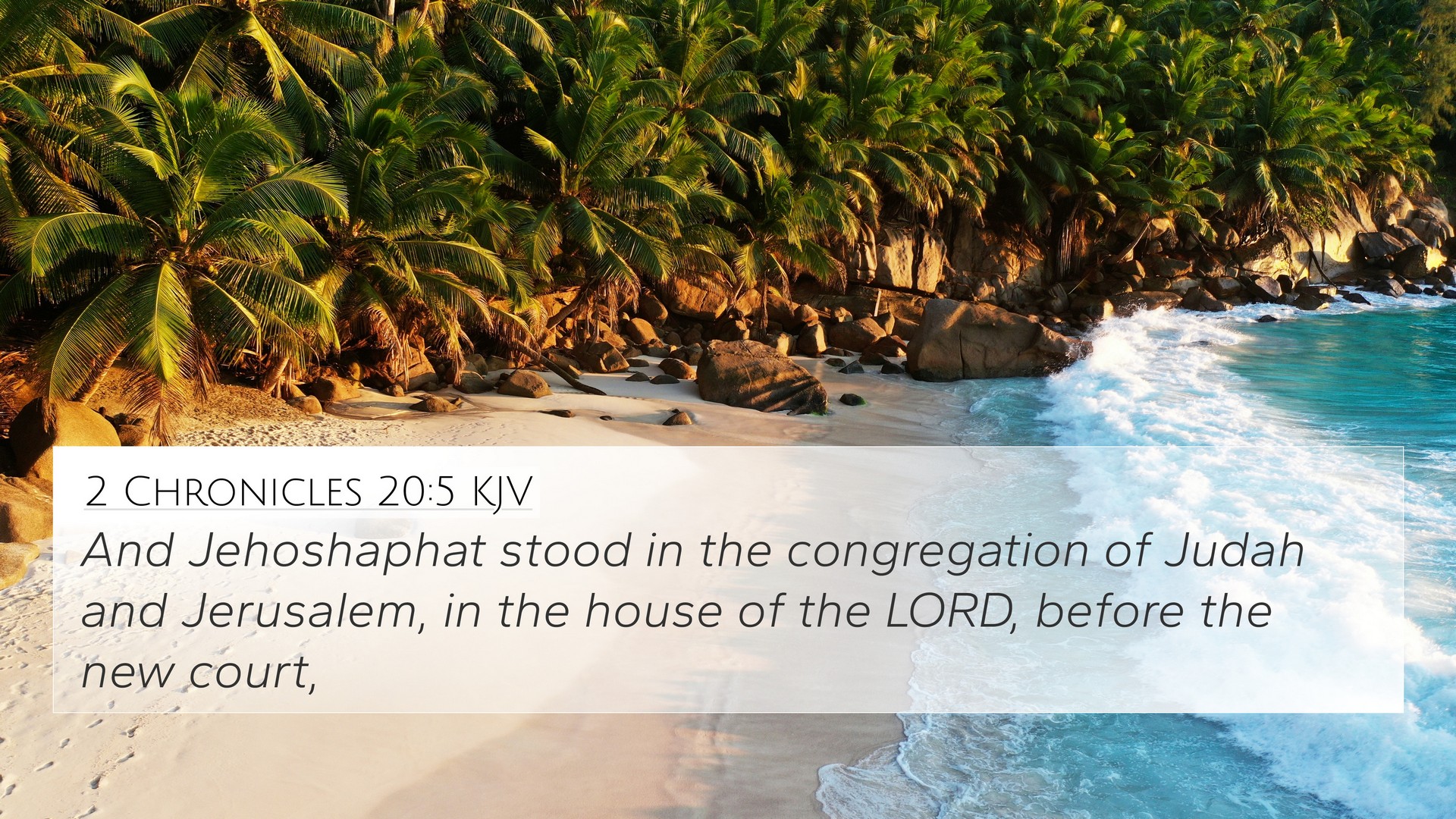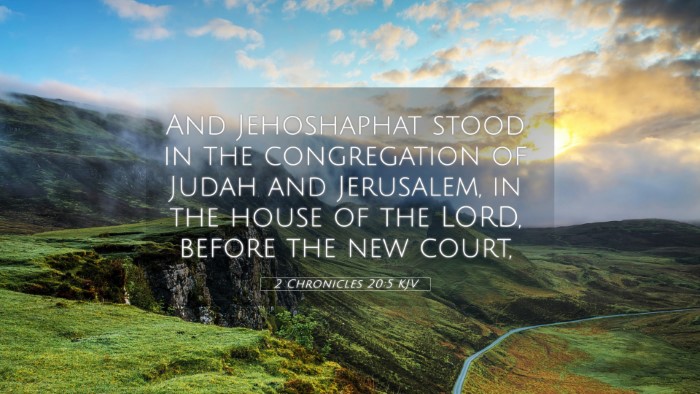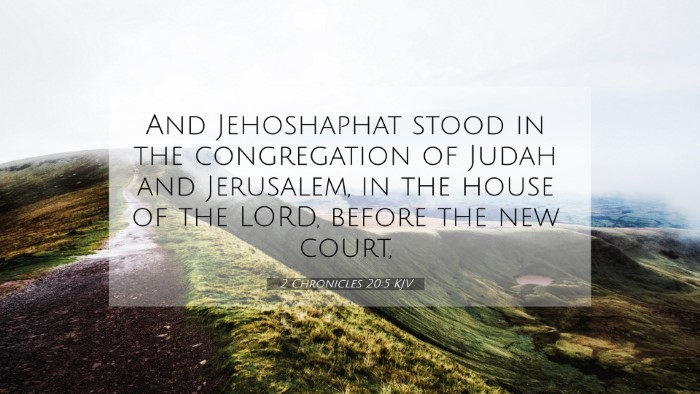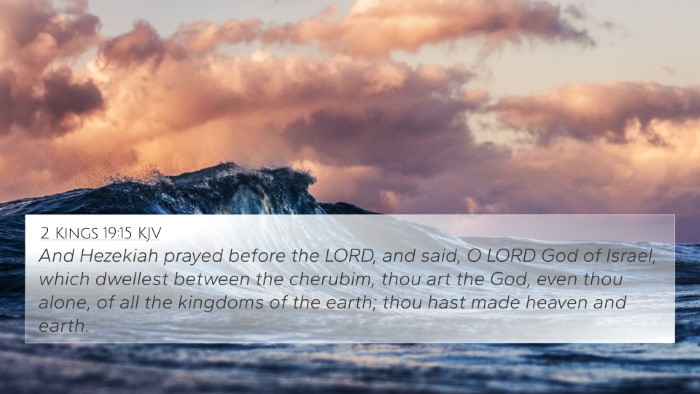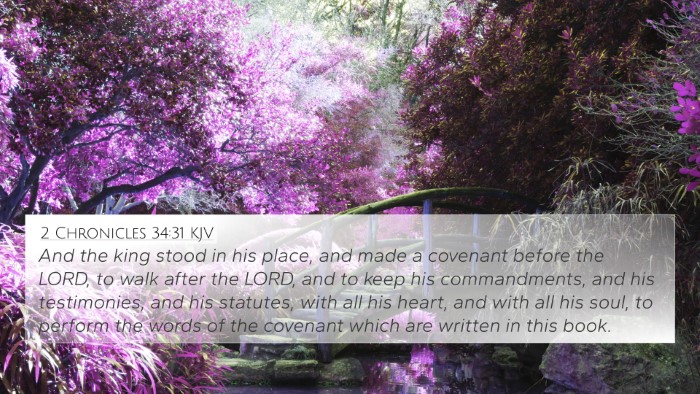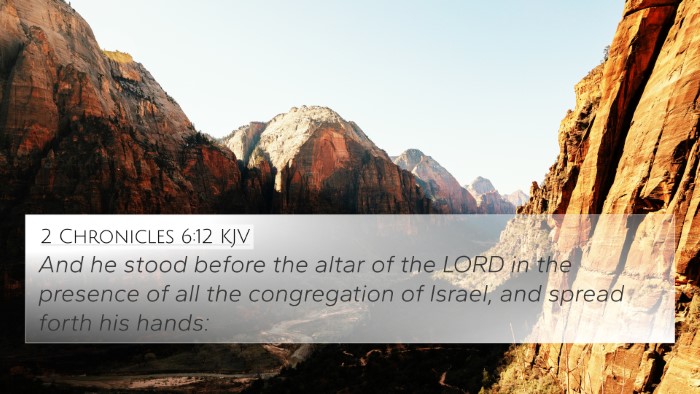Understanding 2 Chronicles 20:5
2 Chronicles 20:5 recounts a moment of profound spiritual engagement by King Jehoshaphat of Judah as he stands before the people in Jerusalem and prays earnestly to God during a time of impending crisis. This verse serves multiple purposes, both historical and theological, and highlights the significance of reliance on divine guidance amid adversity.
Verse Contextualization
To fully understand 2 Chronicles 20:5, we should view it within the broader context of the chapter. Jehoshaphat, facing a formidable alliance of enemies, calls for a national day of prayer and fasting, demonstrating the collective dependence on God for deliverance.
Key Themes
- Leadership in Crisis: Jehoshaphat exemplifies godly leadership by seeking divine intervention rather than relying solely on military might.
- Community Worship: The king’s call to the people to gather for prayer signifies the importance of communal faith practices.
- Prayer as Power: The act of prayer is portrayed as a powerful tool in confronting challenges.
Commentary Insights
Matthew Henry's Commentary
Matthew Henry emphasizes the importance of prayer in the life of a believer, particularly during times of distress. He notes that Jehoshaphat’s choice to assemble the people and lead them in prayer demonstrates the necessity of collective reliance on God. This scene highlights that true strength comes from spiritual engagement rather than mere human effort.
Albert Barnes' Commentary
Albert Barnes adds that Jehoshaphat's prayer marks a significant moment in Israel's history where leadership and faith intersect. He points out that the king's acknowledgment of God's sovereignty and past acts of deliverance is crucial in his appeal. Barnes further notes that Jehoshaphat reminds the people of their covenant identity, reinforcing the concept that God listens to His people when they call upon Him in sincerity.
Adam Clarke's Commentary
According to Adam Clarke, the public nature of the king's prayer is notable. He argues that Jehoshaphat’s appeal to God is not merely for personal deliverance but is a profound declaration of God's ability to intervene in history. Clarke also highlights the model of prayer articulated by Jehoshaphat, marked by adoration, supplication, and a reminder of God's past faithfulness.
Bible Verse Cross-References
To deepen our understanding, here are some Bible verses that relate closely to 2 Chronicles 20:5:
- 2 Chronicles 20:12: Jehoshaphat acknowledges human helplessness against overwhelming odds.
- Psalms 34:4: “I sought the Lord, and he answered me; he delivered me from all my fears.” – Reflects the assurance found in seeking God.
- Isaiah 41:10: “Fear not, for I am with you; be not dismayed, for I am your God.” – A reassurance of God’s presence in times of trouble.
- James 5:16: “The prayer of a righteous person is powerful and effective.” – Highlights the power of collective prayer.
- Philippians 4:6-7: Encouragement to not be anxious but to present requests to God through prayer.
- 1 Chronicles 5:20: A similar theme of divine intervention in Israel’s battles is present.
- 2 Corinthians 1:10: “He has delivered us from such a deadly peril, and he will deliver us again.” – Affirms the faithfulness of God in deliverance.
Connections Between Bible Verses
The connections highlighted in this verse are not just limited to Historical accounts but resonate throughout various books of the Bible, encouraging believers to seek God in times of distress. This interaction between scripture promotes a deeper understanding of God’s character and His faithfulness to His people.
Thematic Bible Verse Connections
As we explore further, the themes of divine sovereignty, communal prayer, and faith amid adversity emerge as prevailing motifs throughout scripture. These themes inherent in 2 Chronicles 20:5 often reappear in the Gospels, letters of Paul, and the Psalms, prompting rich theological reflection.
How to Use Bible Cross-References
When engaging with Bible cross-references, it’s helpful to:
- Utilize a Bible concordance or cross-reference guide to find related verses.
- Identify key terms and themes in the scripture passage, then search for those across the Bible.
- Apply comparative Bible verse analysis to draw insights from connections between the Old and New Testaments.
- Consider the context and meaning of each verse in its narrative and thematic scope.
Conclusion
2 Chronicles 20:5 encapsulates the critical essence of prayer and collective reliance on God amid challenges. By gathering insights from public domain commentaries, we can glean wisdom that transcends time, encouraging modern believers to emulate Jehoshaphat’s example in seeking God’s guidance through prayer. The interconnectedness found through scriptural cross-referencing enriches our understanding and leads us to a profound appreciation of God’s faithfulness and sovereignty.
